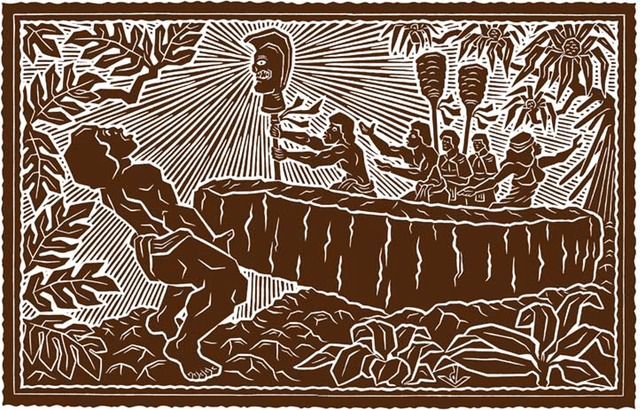At the time of Captain Cook’s arrival (1778,) the Hawaiian Islands were divided into four kingdoms: (1) the island of Hawaiʻi under the rule of Kalaniʻōpuʻu, who also had possession of the Hāna district of east Maui; (2) Maui (except the Hāna district,) Molokai, Lanai and Kahoʻolawe, ruled by Kahekili; (3) Oʻahu, under the rule of Kahahana; and (4) Kauai and Niʻihau, Kamakahelei was ruler.
Kahahana was high-born and royally-connected. His father was Elani, one of the highest nobles in the ʻEwa district on Oʻahu, a descendant of the ancient chiefs of Līhuʻe. While still a child, Kahahana was sent to Maui to live in the court of his relative, Kahekili. (Fornander)
Then Oʻahu chiefs selected Kahahana to be their leader (this was the second king to be elected to succeed to the throne of Oʻahu, the first being Māʻilikūkahi, who was his ancestor.)
Kahahana left Maui and ruled Oʻahu. When war broke out between Kalaniʻōpuʻu of Hawaiʻi Island and Kahekili in 1779, Kahahana had come to the aid of Kahekili.
Later, things soured.
“At that time Kahekili was plotting for the downfall of Kahahana and the seizure of Oʻahu and Molokaʻi, and the queen of Kauaʻi was disposed to assist him in these enterprises.” (Kalākaua)
In the beginning of 1783, King Kahekili from Maui sought to add Oʻahu under his control. Kahekili invaded Oʻahu and Kahahana, landing at Waikīkī and dividing his forces in three columns (Kahekili’s forces marched from Waikīkī by Pūowaina (Punchbowl,) Pauoa and Kapena to battle Kahahana and his warriors.)
Kahahana’s army was routed, and he and his wife fled to the mountains. For nearly two years or more they wandered over the mountains, secretly aided, fed and clothed by his supporters, who commiserated the misfortunes of their former king.
Weary of a life in hiding, Kahahana sent his wife, Kekuapoʻiʻula, to negotiate with Kekuamanohā (her brother, and chief under Kahekili) for their safety. Kekuamanohā sent messengers to Kahekili at Waikīkī informing him of the fact.
Kahekili immediately ordered the death of Kahahana, and he sent a double canoe down to ʻEwa to bring the corpse to Waikiki. This order was faithfully executed by Kekuamanohā. Kahahana and Alapaʻi were killed in Waikele.
Some of the remaining Oʻahu chiefs sought revenge and devised a wide-spread conspiracy against Kahekili and the Maui chiefs. The conspiracy was led by Elani, father of Kahahana and included a number of Oʻahu chiefs.
At the time, Kahekili and his chiefs were quartered in various areas around the island. Kahekili was in Kailua, while others were in Kāneʻohe and Heʻeia, and the remainder in ʻEwa and Waialua.
The plan was to kill the Maui chiefs on the same night in the different districts.
The conspiracy and revolt against Kahekili on Oʻahu was called Waipio Kimopo, (the “Waipiʻo Assassination” – named such, having originated in Waipiʻo, ʻEwa.)
However, before they could carry out their plan, Kalanikūpule found out their intentions and informed his father, Kahekili. Messengers were sent to warn the other chiefs, who overcame the conspirators and killed them. (Apparently the messenger to warn the chiefs in Waialua was too late and the Maui chiefs there were killed.)
It was found to be the best policy for a newly conquered people to give prompt and zealous allegiance to Kahekili, lest his piercing eyes should detect a want of aloha in his newly acquired subjects. For such delinquency he had given the people of a whole town to midnight slaughter. (Newell)
Gathering his forces together, Kahekili overran the districts of Kona and ʻEwa, and a war of extermination ensued. Men, women and children were killed without discrimination and without mercy. This event was called Kapoluku – “the night of slaughter.” (Newell)
The streams of Makaho and Niuhelewai in Kona (Oʻahu,) and that of Hōʻaeʻae in ʻEwa, were said to have been literally choked with the corpses of the slain. The Oʻahu aristocracy had almost been entirely killed off.
Kalaikoa, one of the Maui chiefs, scraped and cleaned the bones of the slain and built a house for himself entirely from the skeletons of the slaughtered situated at Lapakea in Moanalua. The skulls of Elani and other slain Oʻahu chiefs adorned the doorways of the house. The house was called “Kauwalua.” (Lots of information from Fornander and Bishop Museum.)





















